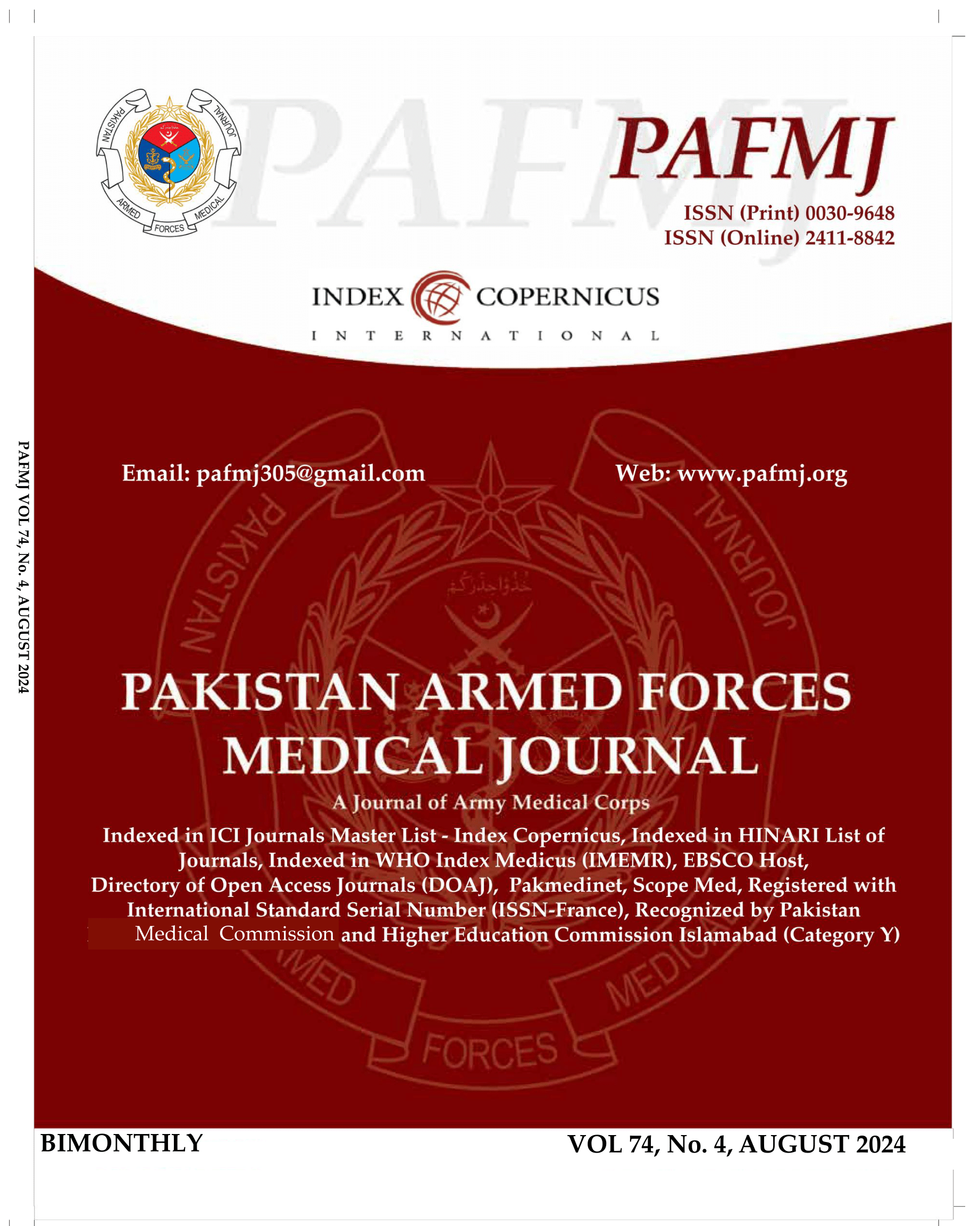Impacts of Problematic Internet use Among Adolescents of Pakistan: A Qualitative Inquiry
DOI:
https://doi.org/10.51253/pafmj.v74i4.10273Keywords:
Adolescents, Internet use, Internet addiction disorder, Protective factors.Abstract
Objective: To explore the impacts of problematic Internet use among adolescents of Pakistan.
Study Design: Qualitative study (Interpretive Paradigm).
Place and Duration of Study: National Institute of Psychology, Quaid-e-Azam University, Islamabad Pakistan, from Nov 2020 to Jan 2021.
Methodology: For the indigenous exploration of problematic Internet use and its impacts on adolescents of Pakistan, eight focus group discussions were carried out online. Half of the focus group discussions were conducted with adolescents (13-19 years) and the remaining half were done with parents of adolescents. Data was transcribed and thematic analysis was done.
Results: Three main themes, including contributing factors to adolescents’ problematic Internet use, impact of problematic Internet use, and protective factors, emerged. Majority of the themes were in line with existing literature such as contributing & protective factors of adolescents’ problematic Internet use, impacts of problematic Internet use on the lifestyle, social & academic life, physical, developmental and mental health of adolescents. A few positive impacts of Internet use were also identified which were also found parallel to the previous literature. The new identified theme in the current data was identified as cultural impacts that were indigenous to Pakistani society. Codes that emerged under this theme included, degeneration of Muslim society, challenging social/religious norms, more demands for privacy, weakening of family system, generation gap, brand consciousness and acculturation.
Conclusion: The study provides insight to the detrimental impacts of problematic Internet use among adolescents of Pakistan, which includ
Conclusion: The study provides insight for the detrimental impacts of problematic internet...
Downloads
References
Kemp S. Digital 2023: Pakistan. We Are Social & Meltwater 2023. [Internet]. Available at:
https://datareportal.com/reports/digital-2023-pakistan (Accessed on June 20, 2021)
Pontes HM, Caplan SE, Griffiths MD. Psychometric validation of the generalized problematic Internet use scale 2 in a Portuguese sample. Comput Human Behav 2016; 63: 823-833.
https://doi.org/10.1016/j.chb.2016.06.015
Beard KW, Wolf EM. Modification in the proposed diagnostic criteria for Internet addiction. Cyberpsychol Behav 2001; 4(3): 377-383. https://doi.org/10.1089/109493101300210286
Kim Y, Park JY, Kim SB, Jung IK, Lim YS, Kim JH. The effects of Internet addiction on the lifestyle and dietary behavior of Korean adolescents. Nutr Res Pract 2010; 4(1): 51-57.
https://doi.org/10.4162/nrp.2010.4.1.51
Chemnad K, Aziz M, Abdelmoneium AO, Al-Harahsheh S, Baghdady A, Al Motawaa FY, et al. Adolescents’ Internet addiction: Does it all begin with their environment? Child Adolesc Psychiatry Mental Health 2023; 17(1): 1-4.
https://doi.org/10.1186/s13034-023-00626-7
Sigman A. Virtually addicted: why general practice must now confront screen dependency. Br J Gen Pract 2014; 64(629): 610-611. https://doi.org/10.3399/bjgp14X682597
Lissak G. Adverse physiological and psychological effects of screen time on children and adolescents: Literature review and case study. Environ Res 2018; 164: 149-157.
https://doi.org/10.4103/ijph.IJPH_288_17
Balhara YP, Mahapatra A, Sharma P, Bhargava R. Problematic Internet use among students in South-East Asia: Current state of evidence. Indian J Public Health 2018; 62(3): 197-210.
https://doi.org/10.4103/ijph.IJPH_288_17
Tsitsika A, Critselis E, Louizou A, Janikian M, Freskou A, Marangou E, et al. Determinants of Internet addiction among adolescents: a case-control study. Sci World J 2011; 11: 866-874. https://doi.org/10.1100/tsw.2011.85
da Costa BG, Chaput JP, Lopes MV, da Costa RM, Malheiros LE, Silva KS. Association between lifestyle behaviors and health-related quality of life in a sample of Brazilian adolescents. Int J Environ Res Public Health 2020; 17 (19): 7133.
https://doi.org/10.3390/ijerph17197133
Piguet C, Berchtold A, Akre C, Suris JC. What keeps female problematic Internet users busy online? Eur J Pediatr 2015; 174: 1053-1059. https://doi.org/10.1007/s00431-015-2503-y
Cabral F, Pereira M, Teixeira CM. Internet, physical activity, depression, anxiety and stress. Psychol Tech Health J 2018; 2(1): 15-27. https://doi.org/10.26580/pthj.art10-2018
Braun V, Clarke V. Using thematic analysis in psychology. Qual Res Psychol 2006; 3(2): 77-101.
https://doi.org/10.1191/1478088706qp063oa
Nielsen, P, Favez, N, Rigter, H. Parental and Family Factors
Associated with Problematic Gaming and Problematic Internet Use in Adolescents: a Systematic Literature Review. Curr Addict Rep 2020; 7: 365–386. https://doi.org/10.1007/s40429-020-00320-0
Liu CY, Kuo FY. A study of Internet addiction through the lens of the interpersonal theory. Cyberpsychol Behav 2007; 10(6): 799-804. https://doi.org/10.1089/cpb.2007.9951
Liu QQ, Yang XJ, Hu YT, Zhang CY, Nie YG. How and when is family dysfunction associated with adolescent mobile phone addiction? Testing a moderated mediation model. Child Youth Serv Rev 2020; 111: 104827.
https://doi.org/10.1016/j.childyouth.2020.104827
Liu S, Zou S, Zhang D, Wang X, Wu X. Problematic Internet use and academic engagement during the COVID-19 lockdown: The indirect effects of depression, anxiety, and insomnia in early, middle, and late adolescence. J Affect Disord 2022; 309: 9-18. https://doi.org/10.1016/j.jad.2022.04.043
Zhou N, Ma S, Li X, Zhang J, Liang Y, Yu C, et al. Peer contagion processes for problematic Internet use among Chinese college students: A process model involving peer pressure and maladaptive cognition. Comput Human Behav 2019; 90: 276-283.
https://doi.org/10.1016/j.chb.2018.09.016
Kojima R, Sato M, Akiyama Y, Shinohara R, Mizorogi S, Suzuki K, et al. Problematic Internet use and its associations with health‐related symptoms and lifestyle habits among rural Japanese adolescents. Psychiat Clin Neuros 2019; 73(1): 20-26.
https://doi.org/10.1111/pcn.12791
Klavina A, Veliks V, Zusa-Rodke A, Porozovs J, Aniscenko A, Bebrisa-Fedotova L. The associations between problematic Internet use, healthy lifestyle behaviors and health complaints in adolescents. Front Educ 2021; 6: 673563.
https://doi.org/10.3389/feduc.2021.673563
Cao H, Sun Y, Wan Y, Hao J, Tao F. Problematic Internet use in Chinese adolescents and its relation to psychosomatic symptoms and life satisfaction. BMC Public Health 2011; 11: 1-8.
https://doi.org/10.1186/1471-2458-11-802
Restrepo A, Scheininger T, Clucas J, Alexander L, Salum GA, Georgiades K, et al. Problematic Internet use in children and adolescents: associations with psychiatric disorders and impairment. BMC Psychiatry 2020; 20: 1-11.
https://doi.org/10.1186/s12888-020-02640-x
Suhail K, Bargees Z. Effects of excessive Internet use on undergraduate students in Pakistan. Cyberpsychol Behav 2006; 9(3): 297-307. https://doi.org/10.1089/cpb.2006.9.297
Tomczyk Ł, Solecki R. Problematic Internet use and protective factors related to family and free time activities among young people. Educ Sci Theory Pract 2019; 19(3): 1-3.
Downloads
Published
Issue
Section
License
Copyright (c) 2024 Kiran Saleem, Nelofar Kiran Rauf

This work is licensed under a Creative Commons Attribution-NonCommercial 4.0 International License.















